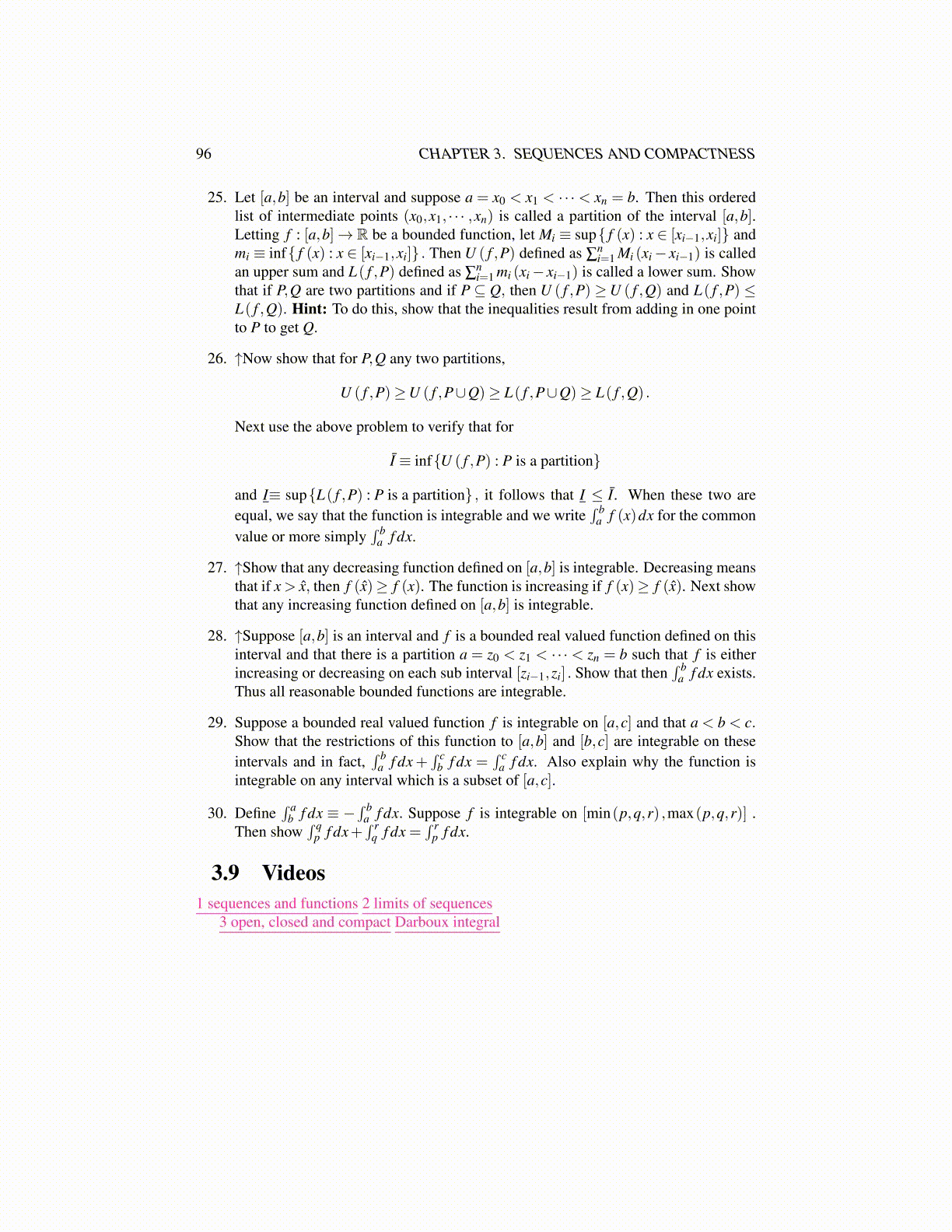
96 CHAPTER 3. SEQUENCES AND COMPACTNESS
25. Let [a,b] be an interval and suppose a = x0 < x1 < · · · < xn = b. Then this orderedlist of intermediate points (x0,x1, · · · ,xn) is called a partition of the interval [a,b].Letting f : [a,b]→ R be a bounded function, let Mi ≡ sup{ f (x) : x ∈ [xi−1,xi]} andmi ≡ inf{ f (x) : x ∈ [xi−1,xi]} . Then U ( f ,P) defined as ∑
ni=1 Mi (xi − xi−1) is called
an upper sum and L( f ,P) defined as ∑ni=1 mi (xi − xi−1) is called a lower sum. Show
that if P,Q are two partitions and if P ⊆ Q, then U ( f ,P) ≥ U ( f ,Q) and L( f ,P) ≤L( f ,Q). Hint: To do this, show that the inequalities result from adding in one pointto P to get Q.
26. ↑Now show that for P,Q any two partitions,
U ( f ,P)≥U ( f ,P∪Q)≥ L( f ,P∪Q)≥ L( f ,Q) .
Next use the above problem to verify that for
Ī ≡ inf{U ( f ,P) : P is a partition}
and I≡ sup{L( f ,P) : P is a partition} , it follows that I ≤ Ī. When these two areequal, we say that the function is integrable and we write
∫ ba f (x)dx for the common
value or more simply∫ b
a f dx.
27. ↑Show that any decreasing function defined on [a,b] is integrable. Decreasing meansthat if x > x̂, then f (x̂)≥ f (x). The function is increasing if f (x)≥ f (x̂). Next showthat any increasing function defined on [a,b] is integrable.
28. ↑Suppose [a,b] is an interval and f is a bounded real valued function defined on thisinterval and that there is a partition a = z0 < z1 < · · · < zn = b such that f is eitherincreasing or decreasing on each sub interval [zi−1,zi] . Show that then
∫ ba f dx exists.
Thus all reasonable bounded functions are integrable.
29. Suppose a bounded real valued function f is integrable on [a,c] and that a < b < c.Show that the restrictions of this function to [a,b] and [b,c] are integrable on theseintervals and in fact,
∫ ba f dx+
∫ cb f dx =
∫ ca f dx. Also explain why the function is
integrable on any interval which is a subset of [a,c].
30. Define∫ a
b f dx ≡ −∫ b
a f dx. Suppose f is integrable on [min(p,q,r) ,max(p,q,r)] .Then show
∫ qp f dx+
∫ rq f dx =
∫ rp f dx.
3.9 Videos1 sequences and functions 2 limits of sequences
3 open, closed and compact Darboux integral